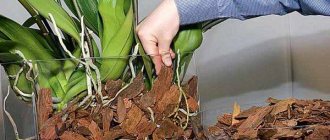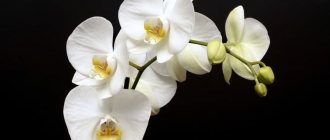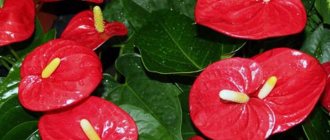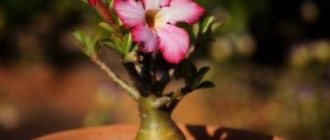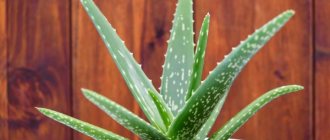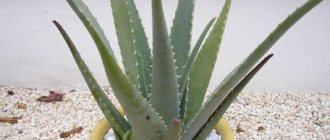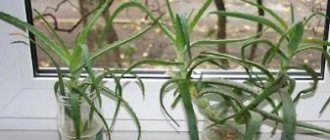≡ Home → Aloe → About aloe →
Most types of aloe have very beautiful flowers, but they rarely bloom at home. Because of this, many people think that the plant does not bloom at all or only once every few decades, although this is not true. In fact, it can even regularly delight you with lush inflorescences at home, if you provide it with the necessary conditions for this.
Aloe vera flowers
In its natural environment, aloe blooms annually, usually in the summer. For domestic plants, the flowering period occurs at the beginning of spring or end of winter. In most cases, aloe produces one tall peduncle from the center of the leaf rosette, on which a lush racemose inflorescence with tubular, less often bell-shaped flowers is formed. They can be red, orange, yellow, pink, and sometimes white.
To see how aloe blooms at home, it needs to be provided with a special temperature regime, proper lighting and watering.
Aloe flowering at home
The likelihood of flowers appearing in aloe occurs only when the plant is mature - it must be more than 5 years old. A prerequisite for this is a period of rest, which should take place during the winter months. At this time, the succulent needs special care.
Desert succulent flowers look very unusual
The flowering process consists of several main stages:
- The appearance of a strong and elastic peduncle.
- Stretching the peduncle up to 35 cm in length (in some varieties of agave it can reach 80 cm).
- The formation of inflorescences consisting of many buds and their gradual increase in size.
- Opening of flowers shaped like hollow elongated tubes.
The color of homemade aloe flowers can be bright orange, less often yellow, pinkish and deep scarlet.
Additional Information! In the first years of life, the flower does not gain color and is useless when trying to treat it with juice. At this time, the plant is actively growing its root system and leaves.
Frequency and timing of flowering
Flower growers who have been growing aloe for a long time note that it blooms no more than once every 15-20 years. However, if the growing conditions are violated, the succulent may never bloom.
In most cases, aloe blooms at the beginning of spring. The possibility of bud formation depends on how the flower overwintered and whether the conditions of maintenance and care were met. By the end of spring, the plant begins to shed faded flowers, but in rare cases, flowering can last until autumn.
Aloe blooms most often in spring
Description and photo
The beginning of the flowering period is marked by the appearance of a peduncle growing from the center of the rosette and decorated with light green buds collected in a pineal inflorescence. After about 2 months, i.e. immediately before flowering, the peduncle reaches a length of approximately 90-100 cm.
The flowers are tubular, yellow or yellow-orange, and from a distance they look like small bananas. They bloom gradually, from bottom to top, with the lower ones falling off by the time the upper ones are just blooming.
In favorable conditions, aloe vera blooms for up to 6 months.
The flowering bush emits a pungent odor, which can lead to headaches.
The most common flowering species
Aptenia care and reproduction: varieties and home conditions
There are approximately 300 known flowering varieties of this succulent. Most of them bloom in spring or early summer. The most popular types:
- Aloe Vera - blooms with bright orange flowers and is considered the most common in indoor floriculture.
- Fan-shaped - its leaf plates are arranged accordingly, and the buds are painted red.
- Aloe Jackson - distinguished by purple-violet tube flowers.
- Aloe Descoings - this variety has triangle-shaped leaves and yellow buds.
- Tree aloe - it is characterized by a variety of flower shades - bright red, light yellow, deep orange and pink.
- Camperi - distinguished by a branched peduncle, at the ends of which there are brushes with scarlet buds.
- A beautiful aloe - its bell-shaped flowers have a purple-coral tint.
- Soapy - the tubular buds of this species are colored in red, yellow or pink tones with specks of a darker shade.
- Frightening (aka Terrible) - the distinctive feature of the variety is the thorns on the leaf blades and bright orange-scarlet inflorescences.
- White-flowered is the rarest indoor species; it came from Madagascar and is distinguished by white-cream buds.
Inflorescences of different species differ in color and shape
General information
The Asphodelaceae family includes many plants. These include liana-like shoots and small herbaceous rosettes. Common features for all varieties:
- a dense trunk of fairly large diameter (if there is one);
- dense, fleshy leaves with an elongated sword-shaped shape (some varieties can boast leaves up to 60 cm long).
The leaves are usually collected in rosettes and arranged in a spiral. There are pronounced spines along the edges, but not necessarily: only small tubercles without spines can be located. In some plants, the leaf blade remains completely smooth along the edge. All varieties of aloe are capable of accumulating moisture; due to this feature, the leaves can swell twice as much as their normal state.
Why don't buds set?
Aloe variegated or tiger - what kind of flower is it?
The reason for the lack of flowering is usually unsuitable conditions. Although the plant itself is unpretentious and grows well in almost any home, it will require special care to help it bloom.
The main reasons for the lack of flowering:
- The age of a particular flower specimen is too young.
- Violation of the irrigation regime, leading to drying out of the soil or stagnation of moisture in it.
- Lack of sunlight.
- Unsuitable soil mixture.
- Depleted soil and lack of nutrients.
- Lack of timely replanting of the plant, which causes crowding of the roots inside the container.
- Non-optimal level of humidity in the room.
- Sudden changes in temperature and drafts.
Factors such as the appearance of parasitic insects and infection with various diseases cannot be ruled out.
How to make aloe bloom at home
For flowering to occur on time, it is necessary to provide the bush with a clear schedule with timely wintering. During rest, internal life processes slow down and resources accumulate for active growth after emerging from hibernation.
Without a noticeable change of seasons, the onset of aloe flowering is impossible
At home, the onset of a dormant period is not typical for agave - it needs to create suitable conditions. To do this, the temperature in the room is gradually lowered to +11... +14 degrees, after which the pot with the succulent is removed to a dark place. They begin to water the flower less and less, gradually reducing the number of procedures to nothing.
Reproduction methods
Aloe vera can be propagated at any time of the year, but rooting is best in early spring. At the same time, it is convenient to replant the flower and separate the root shoots from it.
Rooting cuttings
A cutting for rooting is essentially a leaf cut at the base:
- It must be left at room temperature for 2-3 hours.
- After this, the leaf is planted in wet sand to a depth of 2 cm.
- It is recommended to maintain the high humidity necessary for root growth by spraying with a spray bottle.
- Replant into good soil after active growth begins.
The long process of rooting cuttings may not be necessary if daughter shoots form near the mother plant.
This type of reproduction is typical for older aloe plants (about 3–4 years old). Children need to be separated during spring transplantation and immediately planted in an adult substrate.
Growing from seeds
Purchased seeds are planted in spilled boiling water and cooled soil. The container is covered with cellophane and placed in light at room temperature. In the future, it is necessary to periodically moisten the soil and ventilate the greenhouse for half an hour a day.
When the shoots appear, you should not immediately remove the film - it is better to accustom them to room air gradually over 1-2 weeks.
Care rules on which flowering depends
The natural habitat of the agave is desert areas with dry and hot air, open to direct sunlight. To achieve aloe flowering, you will need to create a comfortable environment for it.
Priming
Aloe tree - what is it, description of the plant
Soil with a neutral or slightly acidic reaction is preferred. You can purchase a ready-made mixture or prepare it yourself from turf soil, river sand and humus. Drainage must be placed at the bottom of the pot.
Note! On the second day after watering, the soil around the succulent should be carefully loosened.
Fertilizers
The plant will develop properly with regular application of mineral fertilizers. To do this, use ready-made complex compositions for succulents strictly in accordance with the instructions.
Watering
The desert flower should not be watered too often, as waterlogging is detrimental to it. For this purpose, settled water is used.
Temperature and humidity level
Although most varieties of aloe can withstand temperature changes from +6 to +28 degrees, it is advisable to maintain an optimal temperature indoors within +18-20 degrees. Humidity should be kept at an average level; there is no need for additional spraying.
A young plant must be replanted annually
How to properly care for blooming aloe
If you managed to achieve budding of the succulent, at this time you should change the care technique. During the flowering period, the bush is provided with maximum peace, only slightly increasing the temperature in the room and increasing the daylight hours to 12 hours with the help of phytolamps.
When the plant gains color, it is advisable to feed it with potassium and phosphorus, and then stop fertilizing. The watering mode does not change.
Note! Once aloe blooms, it becomes poisonous and can cause headaches as well as other ailments in people.
What happens when the petals fall
When aloe blooms at home, the dried flowers and peduncle are carefully removed from the bush. This must be done, since they not only disrupt the decorative appearance of the plant, but also require nutrients.
It is recommended to treat the cut with a solution of potassium permanganate and sprinkle it with crushed activated carbon. Next, the plant is fed with a complex mineral product containing nitrogen and liquid organic fertilizer.
Additional Information. In the wild, after aloe blooms, fruits form in place of the buds. At home, this is impossible, since there is no chance of cross-pollination.
Rest period
For the winter period following flowering, reduce the number of waterings. It is enough just to moisten the soil in a pot with a succulent once a month. Even with no watering at all, the flower will feel great. The plant needs to be watered only when the soil is completely dry.
During the dormant period, the bush is again moved into a room with an air temperature reduced to +10... +14 degrees. The air there must be dry, otherwise the likelihood of infection with fungal diseases increases.
Under favorable conditions, aloe will definitely delight you with flowering
Aloe has many medicinal properties and is used in folk medicine to treat various diseases. The decorative nature of its leaves has made the flower very popular as a houseplant. Due to the fact that aloe blooms very rarely, this phenomenon is considered a good omen, bringing happiness, health and good luck. But, following the above recommendations, you can stimulate the plant and wait for flowering.
History of the succulent
The history of aloe is unusual and fascinating. The perennial is native to Madagascar and South African regions. Even ancient people used the juice and leaves of the perennial to treat wounds and other diseases. The healing succulent flower came to Europe in the 17th century, but did not immediately become widespread and popular among Europeans.
In 1795, the British army, led by General Henry Craig, marched to Cape Town. Upon returning home, one of the officers, as a small but sweet present, presented the general’s wife with a pot of an unusual plant brought from Africa. Mrs Craig was pleased with the gift as she had always loved plants.
One day, the Craig family's maid accidentally broke one of the leaves of the plant while cleaning. Frightened that the hostess would swear, the girl stuck the broken piece of paper into the ground. After some time, the maid noticed that the leaf had not died, but had taken new roots.
This is how the fashion for the thorny flower appeared in the 18th century. It was only in the second half of the 19th century that the plant began to be used for medicinal purposes. Now the perennial is almost an integral part of the apartment; it is grown by people of different ages, since aloe looks great in the interior and has beneficial properties.

